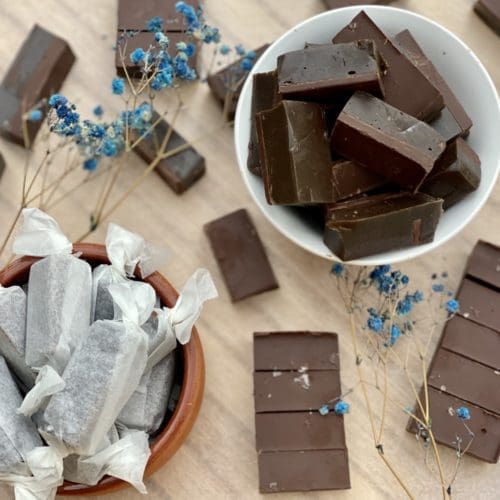
Chocolate Liquorice
These Salted Liquorice chocolate caramels are truly divine. Chewy liquorice with a layer of indulgent, creamy dark chocolate
Ingredients
- 113 gm unsalted butter (chopped roughly)
- 1 cup caster sugar (NOTE 1)
- ½ cup glucose syrup (or corn syrup) (NOTE 2)
- ½ cup sweetened condensed milk (NOTE 3)
- ¼ cup molasses (NOTE 4)
- ½ tsp salt
- ¾ cup plain flour (all purpose flour)
- 2 tbsp pure anise extract (more or less depending on taste) (NOTE 5)
- black food colouring gel (optional)
- 200 gm dark cooking chocolate (chopped roughly) (NOTE 6)
- 2 tsp vegetable oil (or any neutral oil)
- sea salt flakes (optional)
- oil spray for greasing
Instructions
- Grease and line a square 20cm (8in) baking tin with nonstick baking paper. Make sure the paper hangs over the sides of the tin as we'll be using this to lift the liquorice out. Measure the remaining ingredients and have them ready as we have to work fast once the sugar mixture is done.
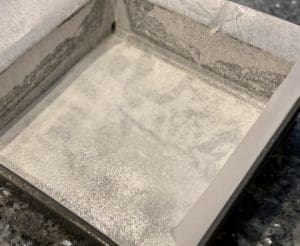
- For the sugar mixture - Place butter, sugar, glucose, condensed milk, molasses and salt In a medium saucepan.
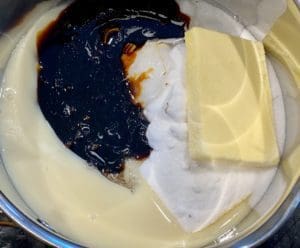
- Place the saucepan over medium heat and stir continuously, scraping the bottom of the pan so it doesn't catch. Bring the mixture to a boil and continue to stir until the mixture reaches 120°C (248°F). If you want a softer caramel chew, remove the sugar mixture from the heat at 115°C (239°F).
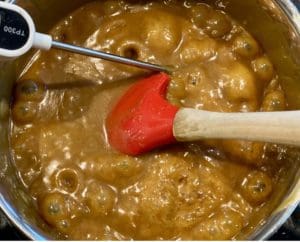
- Add the flour to the sugar mixture and stir quickly until smooth, then quickly stir in the anise extract. It'll make a loud sizzling sound, but this is normal.
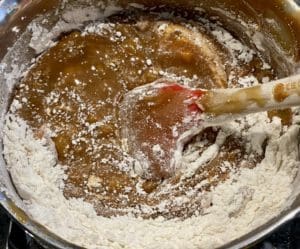
- Place a few drops of black food colouring (if using) into the sugar mixture and give it a good mix. Add more drops of colouring if needed for a darker colour. Pour the mixture into the prepared tin and tilt the tin at all angles so it spreads out evenly. Tap the tin a few times against the table to remove any large bubbles. Leave the liquorice at room temperature for an hour or until it has completely cooled and set.
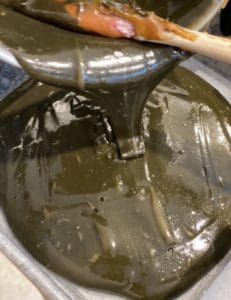
- For the chocolate - Place the chocolate and oil in a microwave-safe bowl and melt it in the microwave. Do this in 40-second bursts, stirring well after each burst until the chocolate has completely melted. Pour the chocolate over the liquorice, then tilt the tin on all angles for an even coating. Lightly sprinkle sea salt flakes over the chocolate, then place in the fridge for an hour until set.
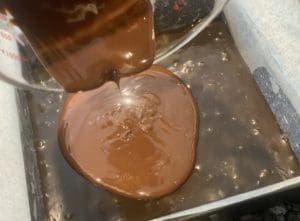
- Leave the tin at room temperature for 15 minutes, then cut it into little candy pieces. To prevent them from sticking together, wrap each candy in baking/parchment paper.
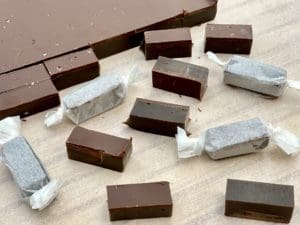
Notes
(NOTE 1) Caster sugar (superfine sugar) - Caster sugar has finer granules than regular white sugar, but it's not the same as icing/powdered sugar. Many baking or candy recipes call for caster sugar as it dissolves faster and better into mixtures. If you can't find caster sugar, you can make your own by placing regular sugar in a food processor or blender. Pulse the sugar a few times until it looks finer, but don't over-blitz to a powder consistency. However, you could just use equal amounts of regular white sugar.
(NOTE 2) Glucose syrup (or substitute for corn syrup) - Glucose is not super sweet, but it's thick and sticky. It's used to make different sweets such as marshmallows, toffee and caramel. Supermarkets usually stock containers of glucose syrup near the baking section.
(NOTE 3) Sweetened condensed milk - Supermarkets usually stock cans of condensed milk near the long-life milk section. It's quite thick and sticky with a very sweet milky flavour. Skim condensed milk is also available, but I haven't tested it out with this recipe as yet.
(NOTE 4) Molasses (or black treacle) - Molasses gives brown sugar its colour and caramel flavour. It's a thick sweet syrup usually found near the baking section of the supermarket, or in the health section. You could also use blackstrap molasses in this recipe.
(NOTE 5) Anise extract - Liquorice extract is difficult to get here, so I used pure anise extract. In testing this recipe, I went through 3 bottles of different brands of anise extract. In doing this, I realised some extracts were stronger in aniseed flavour than others. However, even the strongest bottle still produced a subtle liquorice flavour. I put 2 tablespoons of anise extract in my sugar mixture, and I know this sounds heaps, but it really isn't. To be honest, I wanted to put another tablespoon but my taste testers told me that this batch was perfect. Adjust the amount of extract according to your taste 1 tbsp for mild and 3 for a decent dose of liquorice flavour.
(NOTE 6) Dark chocolate - I prefer using cooking chocolate as they usually have a higher percentage of cocoa butter, which makes it easier to melt and work with. However, any dark or milk (eating) chocolate would work too. If using dark chocolate, avoid using 70% cocoa because it's very bitter.
Leftovers - Store the chocolate liquorice in an airtight container at room temperature for up to 2 weeks.
A Third-Party Application calculated the calories and nutritional information. Please use this as an approximate guide only.
Cooking measurements are in Australian standard spoon and cup measurements.
Nutrition
Serving: 1pieceCalories: 80kcalCarbohydrates: 12gProtein: 1gFat: 3gSaturated Fat: 2gPolyunsaturated Fat: 1gMonounsaturated Fat: 1gTrans Fat: 1gCholesterol: 5mgSodium: 29mgPotassium: 56mgFiber: 1gSugar: 8gVitamin A: 55IUVitamin C: 1mgCalcium: 13mgIron: 1mg